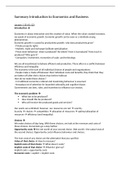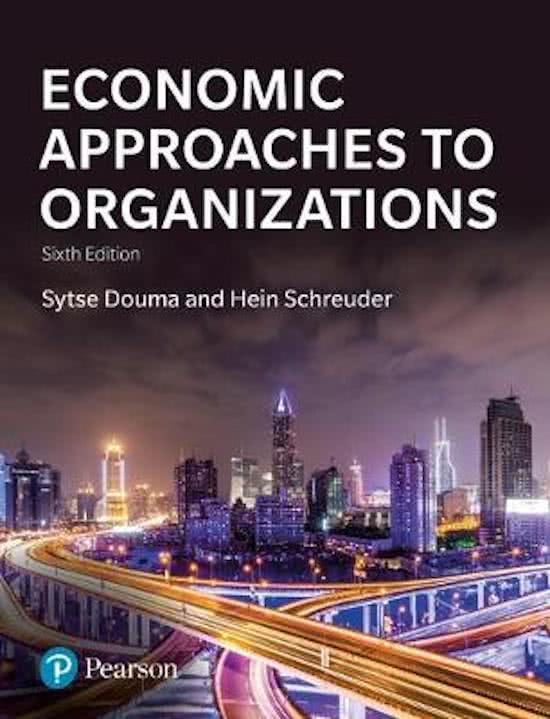Summary Introduction to Economics and Business
Lecture 1 (31-01-22)
Introduction
Economics is about interaction and the creation of value. When the value created increases,
we speak of economic growth. Economic growth can be seen as a relatively young
phenomenon.
Economic growth is caused by productivity growth: why does productivity grow?
- Private property rights
- Markets: trade and exchange facilitate specialisation
- Prices steer behaviour: what is produced? By whom? How is it produced? How much is
produced? Who gets it?
- Companies: investment, economies of scale, and technology
We are all incentivized to behave efficient and productive. There often is a conflict between
efficiency and inequality.
The economy is the sum of all individual choices of people and organizations:
- People make a trade-off between their individual costs and benefits, they think that they
are better off after their choices than before/without
How do we make these choices?
- In traditional economics rational and maximizing behaviour is assumed
- Nowadays lot of attention for bounded rationality and cognitive biases
Governments use laws, rules, and incentives to influence our choices.
The economic problem
What has to be produced?
How should this be produced?
Who will receive the produced goods and services?
Our wants are unlimited; however, our resources are not scarcity.
Scarcity choices competition allocation of resources optimal allocation of
resources efficiency (and inequality).
Choices
We make choices all day long. With these choices, we look at the revenues and costs of
those choices. Economists go a step further.
Opportunity costs the net worth of your second choice. (Net worth = the value/costs of
the second choice). Opportunity costs influence behaviour and choices.
The true costs of any choice are the alternative that you sacrifice:
Value of that choice How to measure?
Explicit costs of that choice What does it costs?
Implicit costs of that choice What do I give up?
Implicit costs = opportunity costs
Economic costs = explicit + implicit costs
,What is the optimal choice?
- Choice which has higher value than economic costs
- Economic rents: difference between value and economic costs
Sunk costs costs that cannot be fully recovered.
Sunk costs fallacy wrongly taking sunk costs into account in decision making
Sunk costs affect our emotions, we experience them as losses
Rule of thumb:
- If previously incurred costs can no longer be reversed, you should include them in your
current considerations
- If previously incurred costs can be (partially) recovered, you should include the costs that
can be reversed as explicit in your current considerations.
With opportunity costs we see which choice we should make between two alternatives.
Another choice we have to make is: How much of something should we produce, buy or
spend our time on?
Rational and optimizing behaviour:
- Which choice yields the highest outcome
- In other words: What is the most efficient choice? Which quantity yields the highest profit,
happiness, utility?
For this we need marginal analysis.
Marginal returns benefits what is the return benefit of one extra unit?
Marginal costs what are the extra costs of one extra product?
This is not always constant. Marginal costs can diminish or increase. Opportunity costs
should be taken into account.
Most efficient point:
marginal returns = marginal costs
or point closest to the where MR > MC
Capitalism Market economy
- The economic problem is solved using markets and prices
- Society determines through demand what is produced and how this is produced
- Prices are determined by individual decisions of people and organizations
Incentives
Governments use sets of instruments to influence choices
Incentives as good/bad behaviour:
- Prices, taxes, subsidies, nudges
- Bonuses
- Mortgage deduction and pension savings
Incentives as unintended consequences:
- Childcare in Israel
- mortgage interest tax reduction
- Chinese sparrows
,Lecture 2 (02-02-22)
Trade and exchange
The size of the economy is measured using ‘Gross Domestic Product (GDP)’:
- The sum of all income/ all value added in an economy in a certain period.
- Production (supply) income demand
- Far from perfect measure
GDP per captia is a more specific measurement method.
A possible source of average productivity is specialization and trade.
In a market economy nobody is self-sufficient:
- Productivity is increased when people/companies/cities/countries specialize
- Specialize in what they are relatively good at / have the lowest opportunity costs
- Increase in average productivity due to (re)-allocation.
As a result, everyone produces more and less than necessary
This is only possible if the ‘surplus’ can be sold on markets, and the shortage can be bought.
The more trade in markets more specialization the higher the average productivity
the higher the wealth. Trade and exchange must be interpreted broadly.
Absolute advantages
After specialization, countries/organizations have to come up with a mutual beneficial ‘term
of trade’. This is any price which is between the internal opportunity costs of both
countries/organizations.
This does not only hold for absolute advantages but also for comparative advantages.
Comparative advantages
The good you can produce the cheapest in relative terms.
Specialization increases the average productivity. Markets and prices facilitate specialization
through transactions. More transactions more specialization higher productivity
higher standards of living.
Consequences of free trade:
1. International trade leads to specialization
2. Because of this: industries and actors that win and actors that lose
Winners
- Everybody involved in production of goods for which the country does have comparative
advantage
- Everybody else, through lower prices
Losers
- Everybody involved in production of goods for which the country does not have
comparative advantage
Trade and exchange (transactions) specialization average productivity GDP
Transactions are facilitated by markets. On markets supply and demand determine:
- What and how much is produced
- How this is produced
- Who receives the production
, Lecture 3 (07-02-22)
Markets
Buyers only demand goods if the price is lower or equal to the value, they derive from it.
Sellers only supply goods if the price is higher than, or equal to, the marginal costs of
production.
There are some basic assumptions concerning (perfectly) competitive markets:
There must be many buyers and sellers
There is free entry and exit
No one is powerful enough to influence prices
Goods are homogeneous
Every buyer and seller have perfect information
Everyone only acts if it is in his/her favour
Markets function in isolation
Criticism: what if these assumptions are partially incorrect?
Demand:
- We look at aggregate demand in one market with one homogeneous good
- Demand = total willingness to pay
- Individual willingness to pay = individual marginal returns/benefits
- At what price is buying something a good deal?
- Negative relationship between price and quantity demanded
- Law of demand: (Ceteris paribus), the quantity demanded of a good decreases as the price
rises.
- This may be true for individual demand, but almost always holds for total demand
- ‘Law of diminishing marginal utility’
Elasticity:
How sensitive is the quantity demanded for a price change?
Sensitive price elastic good
Not sensitive price inelastic good
Elastic goods have a rather horizontal graph, whereas inelastic goods have a vertical graph.
If demand changes without a change in prices, the whole demand curve shifts:
- Price of related goods
substitution goods
complementary goods
- Income
normal goods
inferior goods
- Preferences
taste, hypes, fashion, marketing, technology…
- Size of the population (market)
- Expectations about the future (prices)





